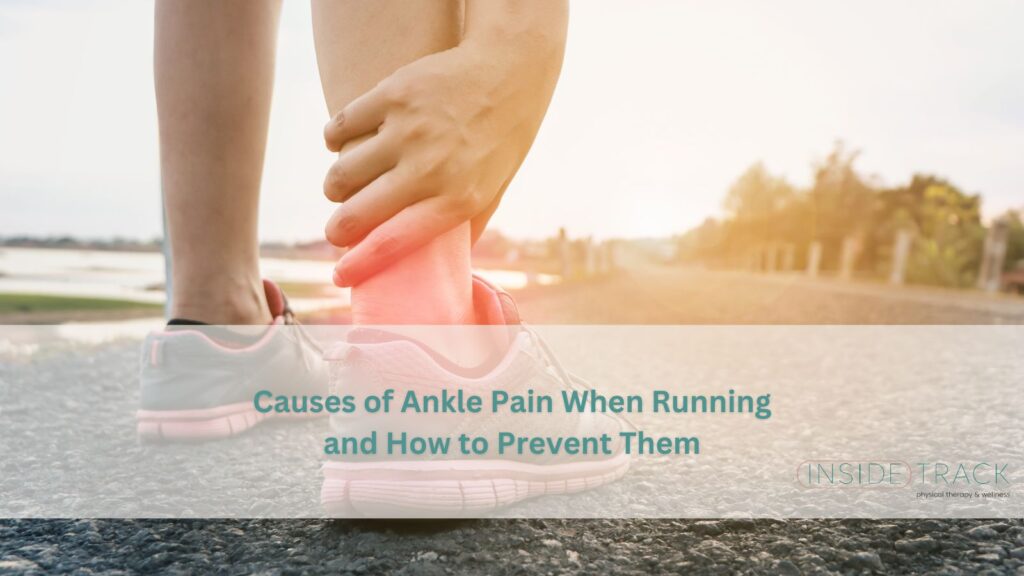
Introduction
Running is a popular form of exercise with numerous health benefits. However, it’s not without its risks, particularly to the ankles. Ankle pain when running can be a frustrating obstacle to achieving your fitness goals. Understanding the causes and prevention methods is crucial for both novice and experienced runners.
Ankle Anatomy
Understanding the intricate anatomy of the ankle is paramount for runners, as it sheds light on the potential origins of ankle pain—a common complaint among the running community. The ankle joint is instrumental in running, offering the essential motion and stability required for propelling the body forward. However, its complex structure makes it prone to a variety of injuries and conditions, leading to discomfort or pain.
To fully grasp why ankle pain occurs, let’s delve deeper into the anatomy of the ankle, highlighting its components and their roles:
Bones: The ankle joint is formed by the interaction of three bones—the tibia (shinbone), the fibula (the smaller bone in the lower leg), and the talus (a bone in the foot). This formation is crucial for providing both stability and support. The tibia and fibula cradle the talus from above, creating a hinge that allows your foot to move up and down.
Ligaments: Ligaments are robust bands of tissue that connect bones. In the ankle, several ligaments, including the deltoid ligament on the inside and the lateral ligaments on the outside, work together to stabilize the joint. They prevent excessive movement that could lead to instability or injury, especially during dynamic activities like running.
Muscles: The muscles surrounding the ankle, including the calf muscles (gastrocnemius and soleus), the anterior tibialis, and the peroneal muscles, play a vital role in movement and support. These muscles contract and relax to control the foot’s movement, allowing for the smooth transition of the foot through the running gait cycle.
Tendons: Tendons are the connective tissues that attach muscles to bones, facilitating movement by transmitting the force generated by the muscles to the bones. The Achilles tendon, one of the largest and most powerful tendons in the body, connects the calf muscles to the heel bone (calcaneus) and is crucial for running, jumping, and standing on the toes. The posterior tibial tendon, anterior tibial tendon, and peroneal tendons also play significant roles in stabilizing the ankle and supporting various foot movements.
A comprehensive understanding of the ankle’s anatomy not only illuminates the causes of ankle pain in runners but also underscores the importance of preventive care, such as strength training, proper footwear, and technique adjustments, to safeguard against common ankle injuries. This knowledge empowers runners to optimize their performance while minimizing the risk of injury, ensuring that they can continue to run safely and effectively.
Understanding Ankle Pain When Running
If you have asked yourself: “Why do my ankles hurt when I run?” You will not be surprised to know that ankle pain in runners is a prevalent issue that can significantly impact your running experience and overall well-being. To effectively address and manage ankle pain, it’s essential to delve into the various factors that can contribute to it. Here, we explore the primary causes of ankle pain when running and share some tips on how to reduce ankle pain while running.
Common Causes of Ankle Pain in Runners
Overuse Injuries
Ankle Strain: Overexertion and repetitive stress on the ankle muscles or tendons can lead to an ankle strain. This injury typically involves the stretching or tearing of these soft tissues, resulting in pain, tenderness, and sometimes, swelling. Runners often experience ankle strains when they push their limits or fail to incorporate adequate rest into their training routines.
Ankle Sprain: Ankle sprains occur when the ligaments supporting the ankle joint are stretched or torn due to sudden twists, turns, or awkward landings. Runners may encounter sprains during trail running or when navigating uneven terrain. The severity of a sprain can range from mild to severe, with symptoms varying accordingly.
Ankle Stress Fracture: Stress fractures in the bones of the ankle are often the consequence of repetitive impact and overuse. These small cracks in the bone can result from the cumulative strain endured during long-distance running or sudden increases in training intensity. Stress fractures manifest as localized pain, particularly during and after running.
Ankle Tendonitis: Tendonitis is characterized by inflammation of the tendons around the ankle joint. Runners are prone to Achilles tendonitis, a condition where the Achilles tendon, which connects the calf muscles to the heel bone, becomes inflamed. This ailment is often the result of overtraining, improper footwear, or inadequate stretching.
Arthritis
In addition, arthritis can also cause ankle pain in runners. Osteoarthritis, the most common type of arthritis, occurs when the protective cartilage in the joints wears down over time. This can lead to pain, stiffness, and swelling in the ankle joint. Rheumatoid arthritis is another form of arthritis that can affect the ankles and other joints, causing inflammation and pain.
Improper Footwear
Examples of Good Footwear: The significance of proper running shoes cannot be overstated. Good footwear provides adequate cushioning, arch support, and shock absorption, reducing the strain on the ankle and minimizing the risk of injury. The use of improper footwear can cause ankle pain without swelling but it does not mean that it is an uncommon problem. Runners should opt for shoes that match their foot type and gait, promoting a natural and comfortable stride.
Examples of Bad Footwear: Conversely, ill-fitting or inappropriate footwear can exacerbate ankle problems. Shoes with inadequate support, worn-out cushioning, or an improper fit can lead to discomfort and instability, increasing the likelihood of ankle pain and injury.
Improper Running Form
The mechanics of your running form play a crucial role in preventing ankle pain. Incorrect techniques, such as overpronation (excessive inward rolling of the foot) or supination (insufficient inward roll), can place excessive stress on the ankle joint. Runners should strive for proper posture, stride length, and footstrike to distribute the impact forces evenly.
Understanding the root causes of ankle pain when running is the first step toward effective prevention and treatment. By addressing these factors, runners can reduce their risk of injury and enjoy a pain-free running experience. In the subsequent sections, we’ll delve deeper into the symptoms, diagnosis, and strategies for alleviating and preventing ankle pain, ensuring that you can continue pursuing your running goals with confidence and comfort.
Symptoms and Diagnosis
Symptoms of ankle pain can include swelling, bruising, stiffness, and difficulty bearing weight on the affected foot. Diagnosis typically involves a physical examination, possibly supplemented by imaging tests like X-rays or MRIs.
How to Reduce Ankle Pain When Running, if it Occurs
RICE Method
Rest, Ice, Compression, and Elevation can help manage initial pain.
Ankle pain is a common issue that many runners face. Whether it’s due to overuse, improper form, or an injury, dealing with ankle pain can be frustrating and hinder your running progress. However, several simple yet effective techniques can help manage initial ankle pain: rest, ice, compression, and elevation.
Resting the affected ankle is crucial in the healing process. When you rest, you allow your body to repair any damage and reduce inflammation. Avoid running or engaging in activities that put stress on the ankle until the pain subsides.
Applying ice to the affected area can help reduce swelling and alleviate pain. Wrap an ice pack or a bag of frozen vegetables in a towel and apply it to the ankle for 15-20 minutes at a time, several times a day.
Compression can also help reduce swelling and provide support to the ankle. Use an elastic bandage or compression sleeve to wrap around the ankle, but be careful not to wrap it too tightly as it may restrict blood flow.
Elevating the affected ankle above heart level can help reduce swelling by allowing fluid to drain away from the area. Prop your foot up on a pillow or cushion whenever possible.
NSAIDs
Nonsteroidal anti-inflammatory drugs (NSAIDs) have long been recognized for their effectiveness in reducing pain and swelling associated with various conditions. When it comes to ankle pain experienced during running, NSAIDs can be a game-changer for many athletes.
Brace
A supportive ankle brace is designed to stabilize the ankle joint, providing additional support and helping to prevent excessive movement or rolling. It can also help alleviate pain and reduce the risk of further injury. There are various types of ankle braces available, including lace-up braces, wrap-around braces, and rigid braces. Consult with a healthcare professional to determine which type of brace is best suited for your specific needs.
Elevation
Elevating the ankle refers to raising it above the level of your heart. This simple yet powerful technique helps to reduce swelling, which is a common symptom of ankle pain. By elevating the ankle, you allow fluid to drain away from the area, reducing inflammation and promoting healing.
How to Prevent Ankle Pain When Running
Regular Exercise and Stretching
Strengthening and stretching the muscles around the ankle can prevent injuries.
Selecting the Best Running Shoes
Choose shoes that fit well and provide adequate support for your foot type.
How Physical Therapy Can Help with Ankle Pain When Running
Ankle pain physical therapy can offer personalized exercises to strengthen the ankle, improve flexibility, and correct running form, significantly reducing the risk of injury.
Inside Track Physical Therapy & Wellness provides top-notch physical therapy services in Goshen, IN, improving the well-being of individuals by offering personalized, evidence-based treatment plans that enhance functionality and promote a pain-free lifestyle. Experience exceptional care with our skilled therapists and achieve optimal health and wellness.
Conclusion
Ankle pain when running is a common issue, but understanding its causes and prevention can keep you on track toward your running goals. By paying attention to your body, wearing the right shoes, and following a proper exercise regimen, you can minimize the risk of ankle pain.
FAQs
How do I stop my ankle from hurting when I run?
Focus on proper footwear, correct running form, and strength exercises for the ankle. Also, make sure that you do not overstrain yourself with any type of physical activity.
Is it bad to run on a hurt ankle?
Running on injured or sore ankles can worsen the injury and limit your range of motion. It’s important to rest and seek treatment if necessary.
Should I wear ankle support when running?
Ankle support can be beneficial for those with previous injuries or weak ankles, but it’s not necessary for everyone. Consult with your doctor or physical therapist before using any type of ankle support for sore ankles.

